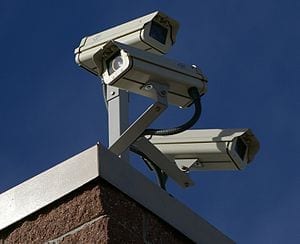
Disturbing revelations about the breadth of spying by the U.S. government on its citizens and allies continue to emerge.
In a recent post, I suggested that U.S. security officials never abandoned the concept of “Total Information Awareness,” a program for intensive digital spying proposed and ostensibly withdrawn by the Pentagon shortly after 9/11.
Another Pentagon phrase that keeps popping up in my head is “persistent surveillance.” I first heard this term while researching “The Drones Come Home,” an article for the March issue of National Geographic Magazine. Predators, Global Hawks and other unmanned planes, or drones, were enabling U.S. armed forces to carry out continuous, 24/7 visual, infrared, radar and electronic monitoring of large regions in Iraq and Afghanistan.
As this 2011 Pentagon report states, persistent surveillance, which like Total Information Awareness was inspired by 9/11, “facilitates the prediction of an adversary’s behavior and the formulation and execution of preemptive activities to deter or forestall anticipated adversary courses of action.”
Incorporating data from conventional aircraft, satellites, balloons and towers as well as drones, persistent surveillance allows U.S. armed forces to predict enemy attacks and coordinate counter-strikes with greater precision than traditional methods.
Such surveillance can also help identify perpetrators of past attacks. For example, if militants blow up a U.S. convoy with an improvised explosive device, persistent surveillance data allow investigators to watch the whole plot unfold in reverse and track perpetrators back to their hideouts. Persistent surveillance turns an entire city into the equivalent of a convenience store monitored by security cameras.
One of the most detailed, candid discussions I have found of persistent surveillance is a 2009 master’s thesis by Christina Fekkes of the Naval Postgraduate School. Fekkes began her paper by recalling the proposal of 18th-century philosopher Jeremy Bentham to create a “panopticon,” a prison whose inmates are monitored so thoroughly that they do not even contemplate misbehaving.
The Latest Bing News on:
Persistent Surveillance
- Ukraine Rethinks Abrams Tank Deployment Amid Persistent Russian Drone Surveillanceon April 26, 2024 at 6:58 am
U kraine has temporarily withdrawn the Abrams M1A1 battle tanks, provided by the United States, from the front lines due to the heightened risk from Russian drone warfare. The decision underscores a ...
- This 15%-Plus-Yielding Passive Income Stock Continues to Deliver Despite Persistent Challengeson April 24, 2024 at 4:43 am
AGNC Investment (NASDAQ: AGNC) pays a prodigious dividend. The mortgage-focused real estate investment trust (REIT) currently yields 15.7%. That's more than 10 times the S&P 500's dividend yield ...
- Scientists report longest known ‘extreme’ Covid infection in 72-year-old manon April 24, 2024 at 2:02 am
Doctors reported the case of a 72-year-old patient in the Netherlands who suffered from the novel coronavirus infection for 613 days, marking the longest SARS-CoV-2 infection duration to date. They ...
- Senate Passes A Key US Surveillance Program For Two More Yearson April 21, 2024 at 10:01 pm
The Senate voted to reauthorize the Foreign Intelligence Surveillance Act (FISA) Section 702, a key surveillance law, for two years with bipartisan support, just before its expiration at midnight on ...
- US Lawmakers Renew Controversial Surveillance Toolon April 20, 2024 at 9:34 am
US lawmakers on Saturday approved the renewal of a powerful electronic surveillance tool widely used by American intelligence agencies abroad, but criticized by civil liberties organizations.
- Your Android phone could have stalkerware — here's how to remove iton April 19, 2024 at 2:15 pm
This guide can help you identify and remove common surveillance apps from your Android phone, including TheTruthSpy, KidsGuard and other apps. Fake passports, real bank accounts: How TheTruthSpy ...
- Fed Says Persistent Inflation Is Seen as Top Financial Riskon April 19, 2024 at 1:42 pm
Higher-than-expected interest rates amid persistent inflation are perceived as the biggest threat to financial stability among market participants and observers, according to the Federal Reserve.
- Report highlights persistent use of Tornado Cash in financial crimeson April 18, 2024 at 12:55 pm
Tornado Cash seems to be the choice of money laundering process for those who use cryptocurrencies. on the OFAC’s sanctions list according to the latest report from CertiK Alert. In the first quarter ...
- Are your kids being spied on? The rise of anti-cheating software in US schoolson April 18, 2024 at 5:00 am
adding that young people could be more susceptible to the potential harms of persistent surveillance. Young children, he argued, are unable to truly consent to being monitored by the software and ...
- Persistent shortage of growth hormone frustrates parents and clinicianson April 17, 2024 at 8:01 am
Dr. Jennifer Miller has been an author of dozens of studies about rare endocrine diseases over the last two decades. Hundreds of patients fly to Gainesville, Fla., from all over the U.S. to see ...
The Latest Google Headlines on:
Persistent Surveillance
[google_news title=”” keyword=”Persistent Surveillance” num_posts=”10″ blurb_length=”0″ show_thumb=”left”]
The Latest Bing News on:
Surveillance
- Perimeter Improvement District spends $173,000 to install area surveillance systemon April 27, 2024 at 10:00 am
The DeKalb Perimeter Community Improvement District has committed $173,350 in funds for a two-year public safety technology partnership with the Dunwoody Police Department, which includes installing a ...
- Christine Quinn claims estranged husband placed quarter-sized hidden cameras in home to keep her ‘under surveillance’on April 26, 2024 at 5:55 pm
The former Netflix star also accused her estranged husband of “trashing” their home so it was unsuitable for living.
- Surveillance video shows David Tepper's visit to local bar with sign critical of himon April 26, 2024 at 5:18 pm
Panthers owner David Tepper paid a surprise visit to a local bar on Thursday night. Recently obtained security footage shows what went down.
- Christine Quinn Claims Husband Placed Hidden Cameras the ‘Size of Quarters’ in Their Home to Keep Her ‘Under Surveillance’on April 26, 2024 at 3:59 pm
In a new filing obtained by PEOPLE, the reality star accuses her estranged husband Christian Dumontet of monitoring her without her “knowledge or consent” ...
- FOX 17 obtains surveillance video showing unmarked police car hit man running from arreston April 26, 2024 at 3:00 pm
Civil rights attorney Ben Crump shared surveillance video with FOX 17 Friday showing the moment an unmarked police cruiser hit 25-year-old Samuel Sterling in Kentwood.
- St. Paul stranger-rape charge: Residential surveillance video helped lead to Maplewood suspecton April 26, 2024 at 10:35 am
A St. Paul woman feared she was going to die when a stranger broke into her home, held a gun to her head and sexually assaulted her, according to charges filed Friday. Police reviewed residential ...
- Police: Video surveillance, DNA used to link man to 2019 Hanover home invasion, shootingon April 25, 2024 at 1:52 pm
A Maryland man faces attempted murder and other charges from a 2019 home invasion robbery and shooting in York County. Eric Morton, 36, also faces charges that include felony counts of robbery, ...
- Cellphone, surveillance video sought as MSP investigates deputy’s fatal shooting of suspecton April 25, 2024 at 10:00 am
Police urge anyone with cellphone or home surveillance video of the incident to contact Detective Sgt. Willoughby at 810-965-4408.
- Surveillance video shows brazen theft in broad daylighton April 24, 2024 at 9:22 pm
An Albuquerque homeowner says a thief made off with a welder, the trailer it was on, and a large toolbox with several tools inside.
- Local law enforcement surveillance policy in question amid expansion of federal intelligence programon April 24, 2024 at 6:36 pm
The renewal of a contentious federal surveillance program made national headlines this week, but some experts argue surveillance on the local level deserves similar attention.
The Latest Google Headlines on:
Surveillance
[google_news title=”” keyword=”surveillance” num_posts=”10″ blurb_length=”0″ show_thumb=”left”]










